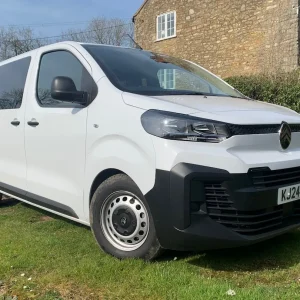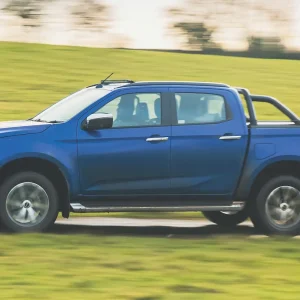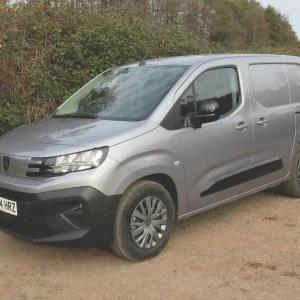How times have changed. Take Citroën, for example. These days its line-up includes the little C2 Enterprise Van, the soon to go on sale and somewhat bigger Nemo, the Berlingo, the Dispatch and the Relay. When the new Berlingo arrives towards the end of the year a version of the existing model will remain on sale, giving the French manufacturer a six-model line-up.
What’s more, some of these models are on offer in a wider variety of configurations than was previously the case. The latest Dispatch is marketed with two wheelbases (L1 and L2) and two roof heights; standard (H1) and high (H2). Its predecessor was restricted to just one wheelbase and one height.
It was with these thoughts in mind that we got to grips with one of the smaller models in the Dispatch range — the short-wheelbase, standard roof L1 H1 1.6-litre HDi diesel.
Technical
Top power of 90hp kicks in at 4,000rpm, while maximum torque of 180Nm makes its presence felt at 1,750rpm. Like virtually all modern light commercial diesel engines, the four-cylinder 16-valve lump features common rail fuel injection technology. Married to a five-speed manual gearbox, it’s additionally equipped with an intercooler and a fixed geometry turbocharger.
The independent front suspension features MacPherson struts plus an anti-roll bar. At the rear you’ll find a trailing arm set-up with coil springs combined with inclined dampers. Our test vehicle’s 16in steel wheels were shod with Michelin Agilis 51 215/60 R16 tyres.
Dispatch is also on offer with a 2.0-litre HDi diesel producing either 120hp or 136hp — a variable geometry turbo is deployed in both cases — married to a six-speed gearbox and combined with disc brakes all round. The humble 1.6-litre has to be content with 280mm-diameter ventilated discs at the front and drums at the back, but at least ABS with Emergency Brake Assist is standard on all Dispatch derivatives.
The 1.6-litre also comes with hydraulically assisted power steering — the 2.0-litres come with an electro-hydraulic set-up — offering a 12.2m kerb-to-kerb turning circle on our test van, with 3.9 turns lock-to-lock.
Grossing at 2,917kg, our Dispatch could handle a 1,200kg payload and tow a braked trailer grossing at 2,000kg. A 1,000kg-payload version is also available.
Load Area
 Access to the 5.0m3 cargo box is by means of a sliding door on each side plus twin rear doors, both of which were glazed and fitted with heaters and a wash/wipe system on our demonstrator for an extra £170; all prices quoted here exclude VAT. They can be pushed through 90° and through 180° if you release the stays.
Access to the 5.0m3 cargo box is by means of a sliding door on each side plus twin rear doors, both of which were glazed and fitted with heaters and a wash/wipe system on our demonstrator for an extra £170; all prices quoted here exclude VAT. They can be pushed through 90° and through 180° if you release the stays.
They open to reveal a load bay with eight cargo tie-down points and with doors — there’s a sliding one on each side — that are panelled to half their height. So are the sides, but there is no protection for the wheelboxes.
We benefited from a full-height steel bulkhead. Available with an overhead storage tunnel for long narrow items, it’ll add around £320 to your final invoice.
Maximum load length is 2,254mm. Maximum height is 1,449mm while maximum width is 1,600mm, narrowing to 1,245mm between the wheel boxes. Front-wheel drive means that the rear loading height is a modest 562mm. The rear door aperture is 1,237mm wide and 1,272mm high. Dimensions for the side door apertures are 924mm and 1,293mm respectively.
Still with figures, it’s worth noting that an H1 Dispatch has an overall height of 1,942mm that will allow it to squeeze into most multi-storey car parks, which usually have a height limit of 1,950mm. That said, you should always remember to double-check a multi-storey’s height limit before you enter because some are lower.
Cab Comfort
 Few people will complain about the amount of storage space in Dispatch’s three-man cab — the middle passenger will find it a squash — but they may raise an eyebrow or two over the way in which it is packaged. Any passenger who opens the lockable glovebox lid will quickly discover that it catches them on the knees when it comes down; not painful, but irritating nevertheless. The lid’s inner surface features a pen tray and cup-holders, although the latter are of little practical use.
Few people will complain about the amount of storage space in Dispatch’s three-man cab — the middle passenger will find it a squash — but they may raise an eyebrow or two over the way in which it is packaged. Any passenger who opens the lockable glovebox lid will quickly discover that it catches them on the knees when it comes down; not painful, but irritating nevertheless. The lid’s inner surface features a pen tray and cup-holders, although the latter are of little practical use.
Most drivers and passengers are also likely to be bemused by the shape of the shelf on top of the passenger side of the dashboard. It looks just like a washbasin and you can’t help but wonder where the taps have gone.
Other facilities for oddments include a cubby-hole, a pull-out cup-holder and a shallow shelf at each extremity of the facia, a shelf beneath the steering column, one beneath the controls for the RDS stereo radio/CD player — you’ll find a set of remote controls on the steering column — and two lidded ones above the windscreen. There are shallow bins with a moulding to hold a flask or a bottle of water in each door and a tray beneath the passenger seat.
One of the vehicle’s big plus points is ease of cab access. Although the handbrake lever is unusually positioned, between the driver’s seat and the door, it does not present an obstacle.
The driver’s seat is height-adjustable — it’s got lumbar adjustment too — as is the steering wheel and most people will find it easy to achieve a comfortable driving position. Cross-cab movement is rather more problematic. The gearstick sits on a moulding that bulges out from the middle of the facia and gets in a driver’s way should he wish to slide across to the pavement side of the vehicle.
A Trafficmaster Smartnav satellite navigation package comes as standard and allows your van to be tracked remotely if it is stolen. The screen can be removed. A 12v power point means you can operate ancillary equipment and there’s another one in the load area.
Electric front windows are included in the price, as is a driver’s airbag. Our test van boasted air-conditioning that covers the glovebox as well as the rest of the cab plus electrically adjustable exterior rear view mirrors for an extra £780 for the entire package.
On the Road
If you’re proposing to tackle a lot of high-speed intercity motorway runs then opt for the 2.0-litres. Both versions have clearly got the edge over their 1.6-litre stablemate when it comes to that sort of work. Around town, however, the 1.6-litre is more than adequate, but If you’re proposing to tackle a lot of high-speed intercity motorway runs then opt for the 2.0-litres. Both versions have clearly got the edge over their 1.6-litre stablemate when it comes to that sort of work.
A good quality gearchange helps you get the best out of the horsepower that’s available. You get plenty of feedback from the steering — far more than you get from the steering on the 2.0-litre Dispatches and low-speed manoeuvrability doesn’t suffer — and that aids the, really quite impressive, handling.
Our test vehicle’s full-height bulkhead eliminated the wind noise and road roar that would otherwise have assailed us from the rear of the vehicle — having driven Dispatches without bulkheads we can testify to the extent of the problem — but did not of course screen out wind noise emanating from other areas of the bodywork; and it’s a bit too high. So far as we can judge it’s coming from the front of the vehicle and from the exterior mirrors in particular.
Unladen the vehicle struggles at times with Britain’s uneven road surfaces, but calms down with some weight in the back. As far as fuel economy was concerned we averaged 37.0mpg.
Central locking with deadlocks comes as standard and can be operated either by buttons on the dashboard or on the remote. It was good to see an alarm fitted, even though it costs an extra £170. Good too to see that the body is protected by side rubbing strips and that the front and back are defended by deep bumpers.
You’ll search long and hard for the bonnet release, only to discover that it’s underneath a little hatch in the floor between the passenger seat and the door. Flip the bonnet open and you’ll find you enjoy easy access to the screenwash reservoir, the dipstick and the oil top-up point.
Falling into Group 6E for insurance purposes, our Dispatch was protected by a three-year/100,000-mile warranty, with no mileage limit for the first two years, and required servicing every 20,000 miles.
Don’t forget that Dispatch is also sold as a Combi, a window van and as a chassis platform.
VERDICT
While it may not be the best choice for high-speed intercity runs — opt for one of its 2.0-litre stablemates if that’s the sort of work you’re usually on — the 1.6-litre HDi Citroën Dispatch is more than adequate for town centre and suburban delivery work. It’s well put together, handles satisfactorily and comes with a gearchange that’s frankly a lot better than we expected it to be. There’s ample oddment storage space in the easy-to-access cab too. On the downside the unladen ride can be poor at times and a lot more work needs to be done to tune out wind noise and road roar. Don’t forget that you can have virtually the same model badged as a Peugeot (Expert) or a Fiat (Scudo), so don’t be afraid to do a bit of shopping around your local dealers until you’ve secured the package that best suits you.

 Life used to be so simple. Go back 25 years or so and all you had to choose from was a small van, a middle sized van, or a big van. If you needed something that didn't quite fit into those rigid categories, then hard luck; you had to make do with what was available.
Life used to be so simple. Go back 25 years or so and all you had to choose from was a small van, a middle sized van, or a big van. If you needed something that didn't quite fit into those rigid categories, then hard luck; you had to make do with what was available.



